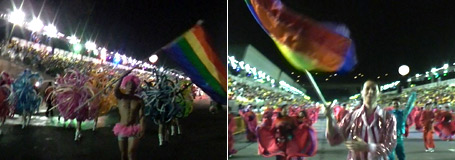With a huge rainbow flag in hand at the annual Chingay Parade last Friday night, two gay Singaporean men have literally put the gay back into Chingay as despite its name, the Chingay Parade is not a gay parade.
The two-day event, which was held in conjunction with the Lunar New Year Celebrations, kicked off at the F1 Pit Building in Marina Bay last Friday night, in front of an 18,000 to 60,000-strong audience (according to numbers reported in various media) which included Prime Minister Lee Hsien Loong.
Roy Tan, a well known member of Singapore’s gay community, posted a message on a local newslist about his intent to march in the parade in January.
“The idea is to have fun and to get Singaporeans used to the idea of people in pink and waving rainbow flags marching along a public thoroughfare. It is not a protest, nor is it intended to have any political or gay message. Once we've softened public opinion after they see how harmless the whole exercise is, applying for a permit to have a dedicated LGBT pride parade along a main road will be so much easier.”
He was joined by Kim, a Singaporean who was visiting from Australia where he currently resides; and according to Tan, the pair was apparently the only two members of the public who signed up on the same day to march that night.
Tan, a 52-year-old healthcare professional, was also the first to moot the idea of a gay pride parade at the Speakers' Corner in Hong Lim Park in August 2008 when rules on public speaking and demonstrations were relaxed. His idea and determination eventually became the foundation of the PinkDot campaign and first-ever official LGBT 2,500-strong public rally held on May 16 last year.
He told Fridae:
“We decided to participate in the Chingay because we wanted to take advantage of the invitation to the public, by the government (specifically, the People's Association which comes under the purview of Ministry of Community Development, Youth and Sports) to march, or rather dance the samba, in a contingent for the very first time in the history of Chingay.
“We wanted to show the government and the Singaporean public what a harmless exercise it was for a contingent, dressed in pink or rainbow colours and waving a rainbow flag, to march in a parade along a major thoroughfare.
“We hope it will soften attitudes enough for the authorities to eventually approve of the organisation of an LGBT pride parade along a main road, instead of merely restricting it to Hong Lim Park. We also wanted to publicly demonstrate our pride in being gay and to set a precedent to encourage other LGBT citizens to take part in future marches. But most of all, we took part because we thought it was going to be fun... and it was!
“Yes, we were disappointed that no one else joined us. There were three people who expressed interest initially but they eventually backed out.
“I hope more LGBT Singaporeans will take part next year and that the government does not take steps to curb our participation. After all, Prime Minister Lee Hsien Loong was the guest-of-honour that night and he applauded as we marched past, just as he did all the other contingents.”
[According to the official Chingay Parade website, there is no historical record of how the word “originated." "But records show that as early as the 19 th century, Chingay appeared in South East Asia, beginning in Penang. The word was coined from its phonetic Hokkien equivalent, which means 'the art of costume and masquerade'. It alluded to a Chinese styled decorated miniature stage or float borne on the shoulders of performers. This miniature stage depicts an important historical scene. It was probably the beginning of the manual float. During New Year processions in old China, such floats were carried through the streets on men's shoulders while dancers, jugglers and magicians entertained the crowds. Huge animals, both real and mythical took part in the processions, which were essentially religious in nature and aimed at honouring deities at the beginning of each new year." Click on chingay.org.sg/2010/about-chingay.asp for more.]

